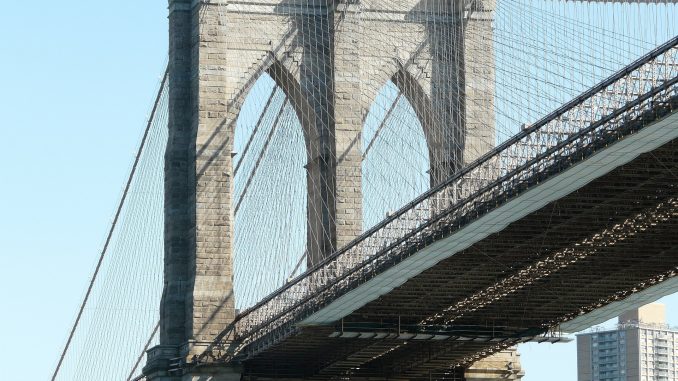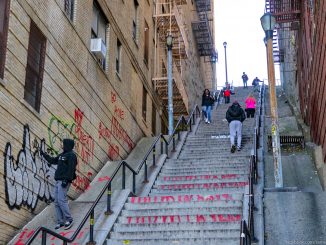
Without The Brooklyn Bridge the city of New York could look very different today in several ways. The combination cable-stayed/suspension bridge was built in 1883 making it one of the oldest continually used and most traveled bridges in the United States. In a sense it was the Brooklyn Bridge itself that helped Brooklyn become a part of New York instead of the quirky neighbor that lives next door. Connecting the boroughs of Manhattan and Brooklyn across the East River it was known as the “New York and Brooklyn Bridge” when it first opened, and at the time of its construction Manhattan and Brooklyn were not boroughs of the same city, but different cities separated by a river.
The bridge was designed by German immigrant John Augustus Roebling, and after a good deal of greased palms and back-room deals construction began in 1869. Roebling was a somewhat famous bridge designer and had previously designed and constructed shorter suspension bridges around the United States, but due to a strange foot crushing injury that resulted in what was probably an exceedingly painful and slow death he was never ever to see the bridge completed. Just before he died, John Augustus passed the project over to his son Washington who dutifully continued his father’s work for three years till he became too ill to continue. Washington developed what at the time was called caisson’s disease by working in the underwater caissons filled with compressed air. An illness more common with deep sea divers, today we call it the bends and have ways to treat it, but Washington Roebling in the late 1800’s did not have access to the modern medical advances we do and had to rely on bed rest and his wife Emily to complete the job.
While Washington was in his bed viewing the construction with a telescope, Emily became his eyes and ears on the ground. She began her work on the Brooklyn Bridge running orders between her husband and his workers at the site, but she ended up essentially taking full control of the project by the time it ended. Emily Warren Roebling is now widely recognized as a pioneering female engineer and one of the driving forces behind the bridge that has stood for more than a century. She went on to earn a degree in law from New York University after completion of the Brooklyn Bridge project and later in life published numerous essays on the importance of gender equality.
Since its opening, the Brooklyn Bridge has been as icon of the city, and since 1964 has been a National Historic Landmark but was interestingly not declared a New York City Landmark till 1967. It was added to the U.S. National Register of Historic Places in 1966 and declared a National Historic Civil Engineering Landmark in 1974. The Brooklyn Bridge has been a monument to the strength of New York and the people that live there since the first people crossed it in 1883.
Brooklyn Bridge Facts
- William “Boss” Tweed, the famous political kingpin of the time paid more than $65,000 in bribes to city aldermen to secure funding for the bridge.
- The Brooklyn Daily Eagle newspaper referred to the project as the “Brooklyn Bridge” in 1867, before it was even built.
- It was called the “New York and Brooklyn Bridge” because it was between two different cities (Brooklyn didn’t become a part of New York City until 1898).
- On May 17, 1884, P. T. Barnum led 21 elephants over the Brooklyn Bridge to prove that it was stable.
- Within 24 hours of opening, an estimated 250,000 people walked across the Brooklyn Bridge.
- Buses are not allowed to cross the bridge but there are water taxis that cover the same distance.
- Although he was mostly recovered from the bends and physically able to leave his apartment, Washington Roebling refused to attend the opening of the bridge
- The bridge officially opened to the public on 24 May, 1883 at 2:00 p.m.
- It used to cost to cross the bridge (one cent per pedestrian and five cents per vehicle).
Walking Across the Brooklyn Bridge
- The Brooklyn Bridge is open to vehicle and pedestrian traffic 24 hours a day and there is not really a bad time to cross, but walking across the bridge during sunset is something special. With views of Brooklyn, Manhattan, and the Statue of Liberty there are great sites to see in every direction.
- If it is anytime other than summer take a jacket or sweater. It can be a bit windy and chilly so make sure you are dressed to enjoy your walk.
- It’s relatively safe to walk across the Brooklyn Bridge at night since there are loads of tourists and commuters, but foot traffic does die down a bit after 11:00 at night.
- Take the trip from Brooklyn to Manhattan for a more impressive view.


